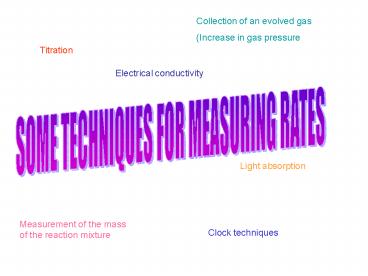SOME TECHNIQUES FOR MEASURING RATES - PowerPoint PPT Presentation
1 / 7
Title:
SOME TECHNIQUES FOR MEASURING RATES
Description:
A tube from the flask which is giving off the gas is placed under water.A test tube full of water is placed upside down above the end of the tube to collect the gas. ... – PowerPoint PPT presentation
Number of Views:30
Avg rating:3.0/5.0
Title: SOME TECHNIQUES FOR MEASURING RATES
1
Collection of an evolved gas (Increase in gas
pressure
Titration
Electrical conductivity
SOME TECHNIQUES FOR MEASURING RATES
Light absorption
Measurement of the mass of the reaction mixture
Clock techniques
2
Collection of an Evolved Gas(Increase In Gas
Pressure)
- The gas produced in the reaction is collected
either in a gas syringe(gas collecting bottle) or
in a graduated vessel over water.
3
All gases can be collected using a gas
syringe. The syringe is connected by a tube to
the flask which is giving off the gas.
The gas syringe has marks along
its lengthwhich allow the volume of collected
gas to be measured.The increase in volume can be
timedand a graph of volume against time can be
plotted.This shows the rate of the reaction.
4
Collecting Gas Over Water A tube from the flask
which is giving off the gas is placed under
water.A test tube full of water is placed upside
down above the end of the tube to collect the
gas. As the gas bubbles into the graduated
vessel it displaces the water until the graduated
vessel is full.
This works well for insoluble gases such as
hydrogen, or gases that do not dissolve easily in
water, such as oxygen and carbon dioxide. Ammonia
and chlorine are readily soluble in water and are
not collected this way.
5
An alternative technique is to carry out the
reaction in a vessel of fixed volume and monitor
the increase in the gas pressure. These
techniques would be suitable for measuring the
rate of reaction between a moderately reactive
metal (such as zinc) and an acid such as
HCl) Zn(s) 2H(aq) Zn2(aq)
H2(g)
6
Measurement of the Mass of the Reaction mixture
- The total mass of the reaction is only vary if
a gas is evolved. To be effective the gas being
evolved should have a high molar mass (i.e. not
hydrogen) so that there will be a significant
change in mass. - This technique would be suitable for measuring
the rate of reaction between a metal carbonate
and an acid by measuring the rate of mass loss
resulting from the evolution of carbon dioxide. - CaCO3(s) 2H(aq) Ca2(aq)
H2O(l) CO2(g)
7
Electrical Conductivity
- The presence of ions allows a solution to
conduct electricity, so if there is a significant
change in the concentrations of ions - (hydrogen and hydroxide ions have a high
conductivity) during the reaction, rate can be
found from the change in conductivity.
Conductivity is an index of ease of flow of
electric current and the reciprocal of
resistivity. Therefore conductivity can be found
by measuring the AC resistance between two
electrodes.
The technique can be suitable for the following
reaction which produces ions from non-ionic
reactants PCl3(aq) 3H2O(l)
H2PO3-(aq) 4H(aq) 3Cl-(aq)

